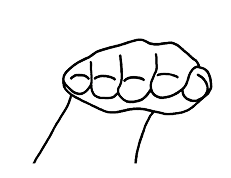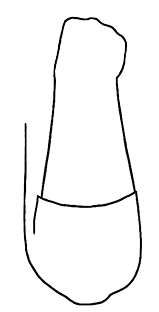Appendix C: Palm, Finger, and Knuckle Orientation
© Bonvillian, Kissane Lee, Dooley & Loncke, CC BY 4.0 https://doi.org/10.11647/OBP.0205.12
Palm Orientation
Palm orientation describes the positioning of the palm(s) of the hand(s) during the production of a sign; in other words, the direction each palm faces as a sign is being formed. Below you will find the written descriptions, as well as drawings, of the common orientations of the palm(s) during signing. (See also “Tips for Using the Sign Lexicon and Sign Index” in Chapter 10, Volume 2.) A flat-hand (the hand is flat with fingers together and extended) is used in the illustrations, which are drawn from the viewer’s perspective. In most instances, the signer’s right hand is depicted.
Finger/Knuckle Orientation
Finger/knuckle orientation describes the positioning of the finger(s) or knuckles of the hand during the production of a sign; in other words, the direction the finger(s) or knuckles point as a sign is being formed. (See also “Tips for Using the Sign Lexicon and Sign Index” in Chapter 10, Volume 2.) In the written descriptions of how the signs are formed, we often include the orientation of the finger(s) or knuckles because palm orientation alone may not be specific enough. For example, consider the following (a flat-hand is used for the illustrations, which are drawn from the viewer’s perspective):
|
|
Palm facing down, fingers pointing forward: the position of the hand when the palm faces down toward the floor and the fingers point out or away from the signer. |
|
|
Palm facing down, fingers pointing in: the position of the hand when the palm faces down toward the floor and the fingers point in toward the signer. |
|
|
Palm facing down, fingers pointing to the (left) side: the position of the hand when the palm faces down toward the floor and the fingers point to the signer’s left side. |
|
|
Palm facing down, fingers pointing to the (right) side: the position of the hand when the palm faces down toward the floor and the fingers point to the signer’s right side. |
|
|
Palm facing down, fingers pointing diagonally forward and to the opposite (left) side: the position of the right hand when the palm faces down toward the floor and the fingers point diagonally forward to the opposite (left) side. |
|
|
Palm facing down, fingers pointing diagonally forward and to the opposite (right) side: the position of the left hand when the palm faces down toward the floor and the fingers point diagonally forward to the opposite (right) side. |
Generally, the most natural hand orientation when a sign is made in front of the body is with the fingers pointing diagonally forward and to the opposite side.
All of the above examples use a palm down orientation, yet the orientation of the fingers varies. Since the fingers are not always extended during the production of a sign, we have also included drawings of the various orientations of the knuckles. The convention used for describing finger/knuckle orientation mirrors the convention used for describing palm orientation. A pointing-hand (the index finger is extended from an otherwise closed hand) is used in the finger orientation illustrations and a fist (the hand forms a fist) is used in the knuckle orientation illustrations. Both are drawn from the viewer’s perspective, with the signer’s right hand depicted in most instances.
Again, the most natural hand orientation when a sign is made in front of the body is with the finger or knuckles pointing diagonally forward and to the opposite side.












.png)
.png)
.png)
.png)
.png)

















